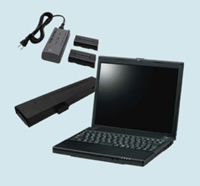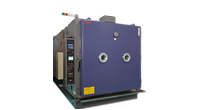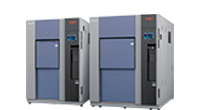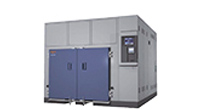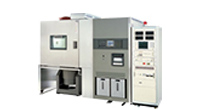
Altitude Temperature Chamber
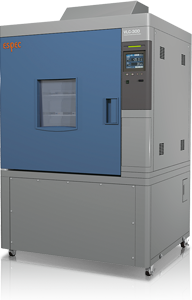
Overview of Equipment
Perform aviation testing (using UN testing criteria) of lithium ion batteries
- Lithium ion batteries are defined as hazardous materials under the UN Restriction of Hazardous Substances*1 and must comply with these restrictions for transportation.
They must pass the UN Manual of Test and Criteria, which includes low-pressure (high-altitude), thermal cycle, vibration, and shock criteria.
This chamber can be used to perform low-pressure (high-altitude) testing in accordance with the UN Manual of Test and Criteria for air transport.
| ※1 | UN standard (Transport of Dangerous Goods and on the Globally Harmonized System of Classification and Labelling of Chemicals Orange Book Ⅲ) defines safety standards for international transportations of a wide variety of hazard objects and these objects are classified into 9 classes (Class 1 to Class 9). UN numbers relating to the lithium ion batteries are following;
Test contents
|
||||||||||||||||||||||||||||||||||||||||
- Operation is easy because of the same instrumentation as a Standard chamber.
- Operability is consistent by adopting the operation panel which is based on the functions of the vacuum oven.
-
Constant operation ··· Number of settings 3 patterns Functions: Start conditions setting, Temperature and pressure control switch off setting, Time signal, Max Min absolute limit alarm setting, Max min variation alarm setting, Name setting Program operation ··· Number of settings 40 patterns (Max. 99 steps per 1pattern) Functions: Start conditions setting, Temperature and pressure control switch off setting, Time signal, Max min absolute limit alarm setting, Max min variation alarm setting, Name setting, Pressure gradient setting, Gas replacement setting, Exposure time setting, Pause setting, Counter setting (A,B*2), End conditions setting (Program chain is possible) *2 2system counter is set. Many kinds of cycle tests can be done by combining the settings.
- Features
-
- Testing that complies with JIS C8712 and UN Manual of Test and Criteria*3 (20°C±5°C, 11.6 kPa or less for at least 6 hours)
- Support for use in a clean room when installed in a clean room
- Magnetic coupling air circulator*4
- Safety devices for protecting the specimen temperature and refrigeration circuit
- *3 UN Manual of Test and Criteria, Part Ⅲ, 38.3.4.1 Test T.1, JIS C8712 (Safety requirements for portable sealed secondary cells)
- *4 Adjust to a move in route, an air bower can be removed from a chamber before transportation. After we check the move in route, we will make a suggestion. Please contact our local sales for more details.
Specifications
Please scroll horizontally to look at table below.
| Model | VLC-201PD | VLC-301PD |
|---|---|---|
| Tempareture Controll range | ー20 to +80 ℃ | |
| Tempareture Constancy | ±0.5 ℃ at Ambient | |
| Tempareture Heat up | +25 → +80℃ within 60 min | +25 → +80℃ within 60 min |
| Tempareture Cool down | +25 → ー20℃ within 60 min | +25 → ー20℃ within 90 min |
| Pressure Controll range | 93.3~9.1kPa | |
| Pressure Lowest | Lower than 9.0kPa | |
| Interior Dimension(mm) | W560×H560×D509 | W800×H800×D696 |
| Volume(L) | 160 | 445 |
| Cooling system | Mechanical single stage(Air cooled) | |
| Vacuum system | Dry pump(Air cooled) | |
- Option
-
- Internal voltage application terminal
- Cleanroom-Ready
- Machinary stand separate adjuster
- Frost free circuit
- Viewing window
- Heavy duty shelf and shelf brackets
- Internal ground terminal
- Dry pump (Vacuum pump)
- Low Out-Gassing Sealant (Silicone)
- Inert Gas Purge Function
Recommended products for customers viewing this product
- Contact us
- Customer Support Desk
Environmental
Test Chambers
- Temperature
(& Humidity) Chambers /
Rapid-Rate Thermal Cycle Chambers- Platinous J Series Temperature
(& Humidity) Chamber - Environmental Stress Chamber
AR series - Rapid-Rate Thermal Cycle Chamber
- Bench-Top Type Temperature
(& Humidity) Chamber - Constant Climate Cabinet
- Compact Ultra Low Temperature Chamber
- Stability Test Chamber (CSH)
- Stability Test Chamber (CWH)
- Walk-In Chamber E Series / High-power Series
- Highly Accelerated Stress Test System (HAST Chamber)
- Temperature
(& Humidity) Chamber FD Series - High-Rate Thermal Cycle Chamber
- VOC Emission Test Chamber
- Altitude Temperature
Chamber - Altitude Temperature
(& Humidity) Chamber - Large Highly Accelerated Stress Test System
(HAST Chamber)
- Platinous J Series Temperature
- Thermal Shock Chambers
- Air to Air Thermal Shock Chambers
Fixed test area type /
Elevator type - Thermal Shock Chamber 300°C Specification
- Large Capacity Thermal Shock Chamber TSA-603EL-W
(600L) - Large Capacity Thermal Shock Chamber
- Liquid to Liquid Thermal Shock Chamber
- Large Capacity Liquid to Liquid Thermal Shock Chamber
- Air to Air Thermal Shock Chamber with Humidity
- Highly Accelerated Air to Air Thermal Shock Chamber (HAATS)
- Air to Air Thermal Shock Chambers
- Temperature Chambers
- Industrial Ovens
Temperature Chamber
Series - Industrial Ovens
Ultra-High Temperature Chamber - Industrial Ovens
Temperature Chamber
with Explosion Vent - Industrial Ovens Temperature Chamber with Rotating Specimen Rack
- Industrial Ovens Anaerobic Temerature Chamber
- Industrial Ovens Large Volume Temperature Chamber
- Desk-top Type High-Temp. Chambers
- Convection Oven
- Industrial Ovens High Performance Clean Oven
- Vacuum Oven
- Slide Tray Oven
- Large Clean Oven
- One-Pass Oven
- Anaerobic Oven
(Less than 100ppm)
- Industrial Ovens
- Network Products
- Example Custom Orders
- Combined Temperature & Humidity Chamber
- Weather Simulation Chamber
- Vertical/Horizontal Vibration Combined Environmental Test System
- Multi-axis Vibration Combined Standard Environmental
Test System - Large Highly Accelerated Stress Test System
(HAST Chamber) - Anaerobic Clean Oven
(SCO Series) - Temperature (& Humidity) Chamber with Large, Double-sided Viewing Window




